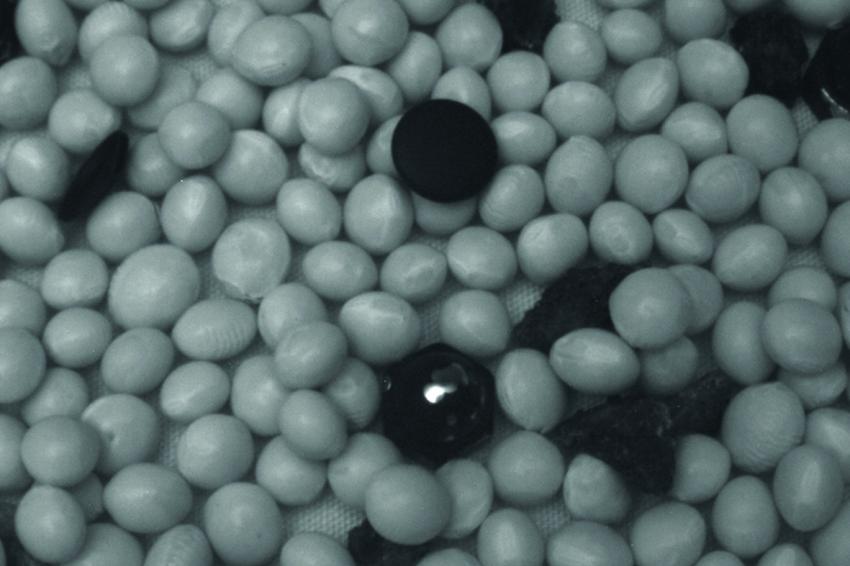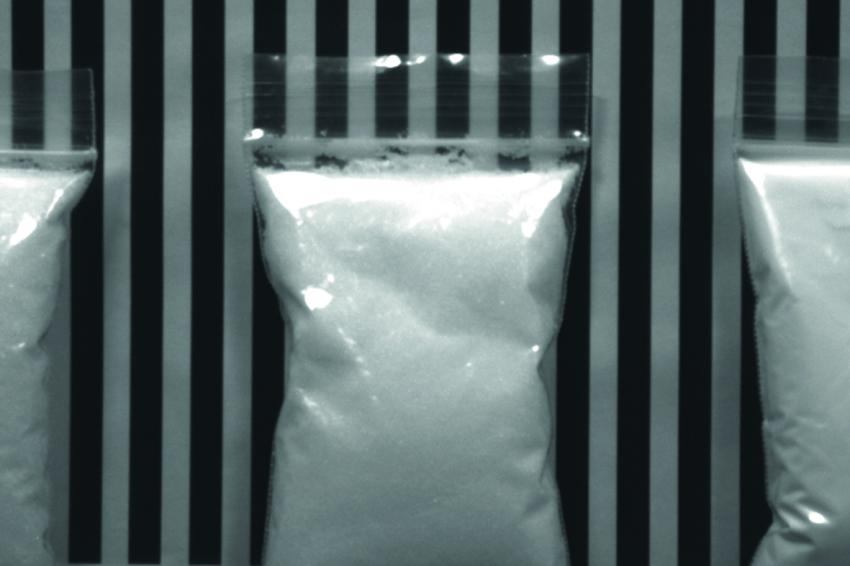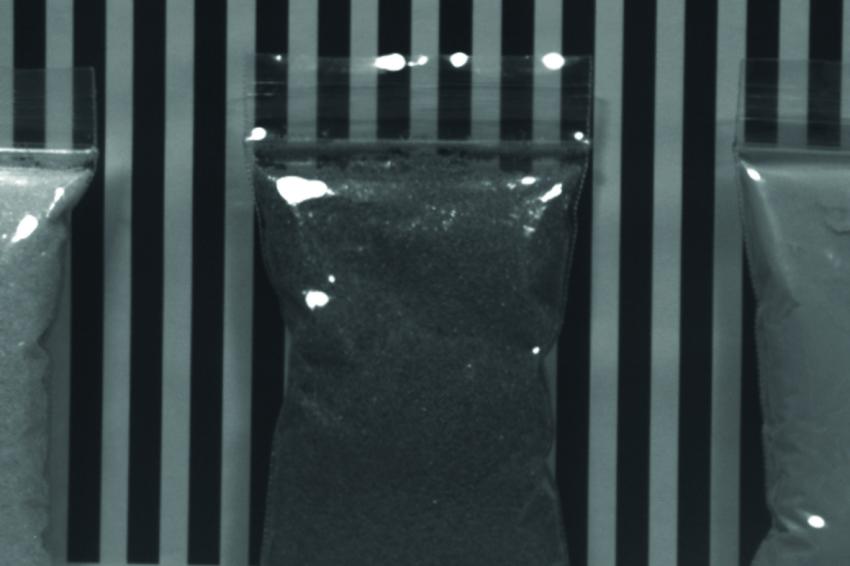Swir Sensors from Sony and Their Applications
Visible as well as NIR and Swir wavelength range for additional information to assess product quality
Although many machine vision applications use light in the NIR spectrum, sensors are typically used that are not optimized for the NIR spectrum as a by-product of classic machine vision sensors and cameras and thus have low quantum efficiency in this range. CMOS-based sensors are sensitive to a portion of the NIR spectrum (about 750 nm to 1,000 nm), but can detect (compared to peak sensitivity) only about 10 percent to 30 percent of the light (at longer wavelengths, this detection capability drops off sharply). In addition, they have a spectral range limited to about 400 nm to 1,000 nm, which does not cover all NIR wavelengths.
To better cover the NIR and Swir wavelength range, an InGaAs sensor can be used. This consists of an indium arsenide (InAs) and gallium arsenide (GaAs) alloy. Typically, these sensors have a spectral response that can vary between 900-1,700 nm and 1,100-2,600 nm. The particular wavelength range of the sensor is already specified in its manufacturing process by a certain InAs and GaAs ratio.
For applications requiring data from the visible as well as the NIR and Swir range, several cameras with different beam paths and different optics have to be used. Overlaying the data sets is complicated and the entire solution is ultimately expensive. In addition, the pixel sizes of a CMOS-based camera are smaller (typically 1 μm to 5 μm) than cameras with InGaAs sensors (typically 10 μm to 20 μm). This makes it even more difficult to merge the data from the acquired images at the pixel level.
Costly multispectral systems
In applications that require a wider wavelength spectrum, multiple cameras often need to be used to capture all the image data in the relevant range. In most cases, specific cameras with different fields of view, optics, and pixel sizes are used for each spectral band. The snapshots produced by these cameras must be calibrated and matched before data analysis can begin. The disadvantage here is that these systems are very susceptible to vibration and misalignment. In order to use the factory calibration unchanged, the mounting of the cameras must be robust so that they do not become misaligned during transport, installation and use and require recalibration. During recalibration, the entire vision system is offline, meaning the inspection system is not in operation and the efficiency or performance of the production line is reduced. Camera manufacturers that incorporate Swir sensors into their equipment must also deal with implementation challenges, such as evaluating dark current levels, heavy shadowing, fixed-pattern noise and large pixel errors. All of this reduces the quality of the output signal and must be taken into account when designing the camera's hardware and software. In addition, many of these cameras use analog sensors, which are quite expensive in their own right and require additional hardware components to control and read out the data. All in all, this increases the overall cost of these cameras, making their use unprofitable in some applications.
Sony's Swir sensor technology
Sony is a relatively new player in the industrial swir sensor market. The latest swir-based technology leverages many of the earlier technologies developed for CCDs and CMOS sensors. It is the world's first non-military CMOS-like sensor that covers both the visible and swir wavelength ranges - an InGaAs-based sensor in which the light-sensitive part is on a silicon (Si) backend with readout and control electronics and memory. A copper-copper contact (Cu-Cu) connects the InGaAs and Si layers. This image sensor covers the visible as well as the NIR and Swir wavelength range with a spectral sensitivity of 0.4 μm to 1.7 μm.
This means that all applications requiring data from these wavelength ranges can be realized with just one sensor or camera, and that the visible light image data matches the NIR and Swir data exactly - at the pixel level, without additional calibration. This advantage greatly simplifies vision system design and image analysis by eliminating the need to compare images and then adjust accordingly.
Sony initially developed two Swir-based sensors, the IMX990 and IMX991, with similar characteristics and features. Both are based on the Pregius digital sensors and accordingly offer CMOS-like operability, functionality and uniformity: All models are housed in a ceramic PGA package and have the same pin configuration. Thus, no different board designs are required for the sensors. Each model can be optionally equipped with single-stage Peltier elements for thermoelectric cooling (TEC) to reduce noise accumulation due to dark current (due to heat generation when capturing images with longer exposures). Using TEC, a temperature difference of about 30 °C can be achieved (with a temperature Ta of 45 °C).
Both sensors use Sony's new Senswir technology: by using a thinner indium phosphide (In-P) surface layer, this enables better detection of the visible wavelength over a wider range. Combined with the Cu-Cu interconnect, this technology can greatly reduce the size of the pixels. At 5 μm, the sensors have the smallest InGaAs-based pixels in the industry, according to the manufacturer. Quantum efficiency (QE) in the visible range is uniform; in the NIR range, it is very high - peaking at more than 75 percent at 1,300 nm. The IMX990 (1/2-type) sensor offers SXGA resolution (1,280 x 1,024) at 130 fps, while the IMX991 (1/4-type) offers VGA resolution (640 x 512) at 250 fps. Both global shutter sensors output the image data via a 2- and 4-channel SLVS transceiver, respectively. Their smaller packages and digital signal transmission make them easier and faster to implement in any new camera design.
Application areas
Machine vision applications have long used a variety of sensors to capture images at different wavelengths. In theory, there are many multispectral applications in the market, but in practice the high cost inhibits the standard use of cameras to capture non-visible wavelengths. For this reason, the new Sony sensors are already anticipated by the machine vision industry. Certain industries can benefit directly from a camera that captures visible light, including the swir spectrum:
Application 1: Food processing and monitoring
In the images taken here, the most important thing is the contrast, through which you can easily see defects and dirt, because they reflect light differently than an unobjectionable product. Normally, high contrast to highlight the defective areas is achieved by using different colored light and/or color filters. However, when the foreign material has a similar reflectance spectrum as the food, for example when sorting beans, the user faces special challenges. In such a case, metal, stones and plastic are difficult to detect in the visible spectrum. However, as soon as they are analyzed in the swir range, they stand out visually and they can be easily filtered out of the mixture.
Application 2: Differentiation of salt, sugar and flour
Another application is the discrimination of salt, sugar and flour. All of these foods look very similar in the RGB spectrum, but have different reflectivity to swir light. When the powdered foods are exposed to SWIR light and imaged with a Swir camera, they can be easily identified and sorted uniquely.
Application 3: Detecting defects and bruises on fruit
Fruit can have defects and bruises without being noticed right away. Often, you don't notice them until it's on the supermarket shelves. But then customers don't buy it; it goes to waste and occupies space that could be used for spotless fruit. Swir-based inspection systems can look behind the fruit bowl to identify defects and sort out fruit for further processing. This can ensure that only the best fruit makes it to the shelves and, because of the better quality, fetches higher prices from discerning customers.
Conclusion: Broad wavelength spectrum for additional information
In many applications, coverage of a wide wavelength spectrum is advantageous because it can provide additional information for assessing the quality and performance of a product. Until now, the high cost of Swir-based cameras has limited their use in various industries. SenSWIR technology and Sony's image sensors have changed this by providing a cost-effective solution for a wide wavelength spectrum. The solution minimizes the complexity of designing a vision system and enables hyper- and multispectral imaging in many markets. As camera designers use and evaluate these sensors to solve their requirements and existing challenges, many more use cases can be realized.
Author
Darren Bessette, Category Manager Devices












